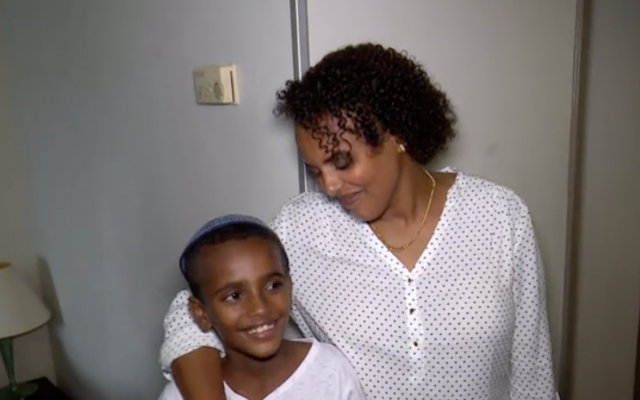Australia/Israel Review
Gaza and the Rockets of October
Nov 1, 2018 | Amotz Asa-El

It was the longest minute in Miri Tamano’s 39 years. Woken up at 3:39 AM by a rocket-alert siren that travelled through Beersheva’s empty streets, the single-mother of three rushed upstairs to the bedrooms of her kids, ages nine, ten and 12, ran with them downstairs to the flat’s safe room and locked its heavy metal door behind her. Barely a second later, a rocket pierced the façade of her two-story unit, leaving nothing intact except the thick-walled safe room.
The following morning, the Ethiopian-born Tamano became a national media heroine for the poise she displayed while saving her family from sure calamity. Yet besides Tamano, there have been no victors on either side of the border in recent months of violence and unrest launched against Israel from Gaza.
Hopefully, the rocket that destroyed Ms. Tamano’s home on October 18 marked the end of half a year of violence that, while inventive on the part of its Palestinian instigators and testing for its Israeli targets, nonetheless left its perpetrators with no significant military achievements or political gains.
The main new weapons in this showdown have been incendiary balloons and kites unleashed on Israeli farmlands and forests, and human phalanxes unleashed on the fence that straddles the border between the Gaza Strip and the Jewish state.
The human assaults have been attempted intermittently since 30 March, when some 20,000 mostly juvenile civilians approached the fence while squads of Hamas fighters mingled among the multitude and tried to cut holes in or climb the fence, torch car tyres, plant explosives and hurl Molotov cocktails at the Israeli troops across the border.
IDF snipers stationed along the fence were ordered to target warriors and to shoot only with an officer’s approval in fending off the onslaught. By day’s end, according to Hamas, they had killed 17 Palestinians.
Hoping to turn this tactic into a strategic weapon, Hamas said the following week it would grant US$3,000 to the family of anyone who gets killed on the border fence, US$500 to the family of anyone seriously wounded, and US$200 for families of the lightly wounded.
The human assaults were then repeated and multiplied, peaking on May 14 when Hamas claimed 58 people – most later conceded to be Hamas members – were killed in unrest it organised purportedly as a response to the American embassy’s transfer that day to Jerusalem.
The assaults on the fence were a Hamas improvisation after the tunnels it planned to deploy as a strategic weapon against Israel were rendered obsolete, thanks to an Israeli underground barrier being newly installed that detects them from within the earth, deploying geo-sensitive technologies.
The IDF has detected and destroyed 15 tunnels since Oct. 2017 – some dug 20 metres underground and all built with electric wiring and concrete walling, designed to let terrorists from Gaza enter Israel unseen.
Having cost more than 150 Palestinian lives so far, including many Hamas fighters, as well as one IDF soldier hit by a Hamas sniper in July, the skirmishing at the fence came coupled with the steady launching of incendiary balloons and kites.
Having mostly landed within some five kilometres of the border fence, the airborne incendiaries have, since April, sparked some 2,000 wildfires in the vicinity of some 57 Israeli villages and towns. By mid-summer, they had consumed a total area of some 12,000 acres. About a quarter of the damaged area is farmland, mostly wheat fields and avocado groves, while the fires seriously damaged four nature reserves.
The missile that landed in Beersheva, and another that landed in the sea outside an unspecified coastal town, took into the Israeli hinterland what had previously been a protracted border skirmish. Expectations for major military action in response on Israel’s part were therefore rife.
Israel’s immediate response to the rocket firings came at dawn the following morning, with a broad aerial attack on 20 targets outside Gaza City that the IDF said were associated with Hamas and the Islamic Jihad.
Israel ignored both organisations’ claims that they did not fire the rockets. Only they possess those types of rockets in Gaza, said IDF Spokesman Brig.-Gen Ronen Manelis, who added that the IDF anyhow held Hamas responsible for what is fired at Israel from Gaza, no matter who technically presses the trigger.
The Palestinian denials appear to stem from a concern in Gaza that the violence had gone too far, and might now spark what, from Hamas’ point of view, would be an Israeli overreaction.
The quest to make Israel hold its fire had in August produced an unsuccessful Egyptian-brokered informal effort to achieve an unwritten “quiet-for-quiet” truce between Israel and Hamas.
The quest for a truce seemed to be echoed in a rare interview that Hamas leader Yahya Sinwar gave to the Israeli daily Yediot Aharonot, through a correspondent for the Italian La Repubblica last month.
“I don’t want more wars,” said the 56-year-old Sinwar, who spent 22 years in prison for multiple murders of Palestinian “collaborators,” before being released in 2011 as part of the deal to release captured IDF Corporal Gilad Shalit.
Sinwar made no hint, even in this unusual address to the Israeli public, that he is prepared to abandon Hamas’ official platform which calls for Israel’s annihilation – much less to follow Palestinian Authority President Mahmoud Abbas’ example and recognise Israel.
The impression in Jerusalem is that Hamas, having failed to deliver jobs, housing, fuel, and water during its 11-year rule, now fears social upheaval. It therefore wants to buy several years of quiet during which it would prepare for another big bout of large-scale conflict with the IDF – possibly on the scale of summer 2014’s six-week showdown in which 73 Israelis and more than 2,000 Palestinians lost their lives.
This scepticism is shared by all Israel’s ruling coalition parties, and in fact also by the major opposition party, the Labor-led Zionist Union. Hamas is seen by Labor as a major culprit in last decade’s collapse of the Oslo peace process, which Labor conceived and led.
Where Israelis differ is within Netanyahu’s coalition, in which politicians to Netanyahu’s right are lobbying for more drastic action.
Back in August, when hawkish Defence Minister Avigdor Lieberman reluctantly participated in the indirect contacts with Hamas, Education Minister Naftali Bennett attacked his “hesitance” in the use of military force and warned it would bring a “clash whose terms will be dictated by Hamas.”
It had not been that long since Lieberman, while in opposition, played the hardliner – asserting in 2015 that “the only agreement reachable with Hamas is that they will be buried underground,” and in 2016 that he would give Hamas’ leaders a 48-hour ultimatum to release the bodies of IDF soldiers it was holding or be killed.
Yet Lieberman, who heads the secular-nationalist Yisrael Beytenu party, has actually behaved in quite a pragmatic fashion since becoming defence minister two years ago. Bennett, who heads the religious-nationalist Bayit Yehudi party, is now the one eyeing hawkish voters from Lieberman’s electorate, and thus breathing down his neck.
Still, with a general election scheduled for November 2019, and expected by many to be held earlier than that, the more bellicose Lieberman of old reappeared, telling Israeli TV, “Hamas’ leaders should have no illusions, we are ready to deal the harshest blow there is.”
Just what that blow might constitute Lieberman did not specify. Instead, ministers to Netanyahu’s left, most notably Housing Minister Maj-Gen (res.) Yoav Galant of the Kulanu faction, a former commander of the Southern Command, accused Lieberman of grandstanding without having a clear plan.
Netanyahu, for his part, likely has little appetite for a big military showdown right now.
As he sees things, the challenge to Israel emanating from Gaza is dwarfed by the Iranian threat Israel faces in general, and in Syria in particular. A major operation in Gaza would constitute a distraction from his main strategic focus, as well as potentially costing too many lives and delivering too little change.
Moreover, unlike Labor and its allies, Netanyahu does not see much merit in a scenario whereby Hamas’ nemesis, the Palestinian Authority, returns to control in Gaza – at least as long as it is led by Abbas, who pays money to terrorists’ families and has also uttered some classically antisemitic exhortations in recent months.
Netanyahu is apparently fine with a status-quo whereby Hamas retains its control of Gaza, but is deterred from unleashing the kind of violence it has been organising since March.
It is an attitude that can work provided quiet lasts, as it largely seems to have since that rocket flew 40 kilometres from Gaza to Beersheva.
That quiet might not have evolved had the Tamano family not made it behind concrete walls and a heavy metal door before the rocket hit.
Seen this way, Miri Tamano may have not only saved her family’s lives, but also prevented a war.






